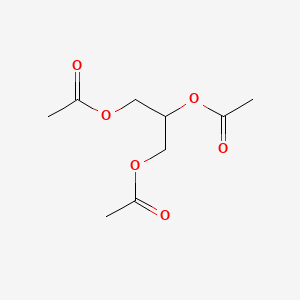| MeSH term | MeSH ID | Detail |
|---|---|---|
| Hemolysis | D006461 | 131 associated lipids |
| Body Weight | D001835 | 333 associated lipids |
| Glioma | D005910 | 112 associated lipids |
triacetin
triacetin is a lipid of Glycerolipids (GL) class. Triacetin is associated with abnormalities such as Vesicular Exanthema of Swine and Lobomycosis. The involved functions are known as National Institute for Occupational Safety and Health (U.S.), Softening, esterase activity, Process and Cell Growth. Triacetin often locates in Tissue fiber, Cell surface and Cytoplasmic matrix. The associated genes with triacetin are GRAP2 gene and Immobilized Proteins. The related lipids are Labrafil M 1944 CS, ethyl oleate and glyceryl monostearate.
Cross Reference
Introduction
To understand associated biological information of triacetin, we collected biological information of abnormalities, associated pathways, cellular/molecular locations, biological functions, related genes/proteins, lipids and common seen animal/experimental models with organized paragraphs from literatures.
What diseases are associated with triacetin?
triacetin is suspected in Vesicular Exanthema of Swine, Lobomycosis and other diseases in descending order of the highest number of associated sentences.
Related references are mostly published in these journals:
| Disease | Cross reference | Weighted score | Related literature |
|---|
Possible diseases from mapped MeSH terms on references
We collected disease MeSH terms mapped to the references associated with triacetin
PubChem Associated disorders and diseases
What pathways are associated with triacetin
There are no associated biomedical information in the current reference collection.
PubChem Biomolecular Interactions and Pathways
Link to PubChem Biomolecular Interactions and PathwaysWhat cellular locations are associated with triacetin?
Visualization in cellular structure
Associated locations are in red color. Not associated locations are in black.
Related references are published most in these journals:
| Location | Cross reference | Weighted score | Related literatures |
|---|
What functions are associated with triacetin?
Related references are published most in these journals:
| Function | Cross reference | Weighted score | Related literatures |
|---|
What lipids are associated with triacetin?
Related references are published most in these journals:
| Lipid concept | Cross reference | Weighted score | Related literatures |
|---|
What genes are associated with triacetin?
Related references are published most in these journals:
| Gene | Cross reference | Weighted score | Related literatures |
|---|
What common seen animal models are associated with triacetin?
There are no associated biomedical information in the current reference collection.
NCBI Entrez Crosslinks
All references with triacetin
Download all related citations| Authors | Title | Published | Journal | PubMed Link |
|---|---|---|---|---|
| Amsalem O et al. | Phospholipids embedded fully dilutable liquid nanostructures. Part 1: compositions and solubilization capacity. | 2009 | Colloids Surf B Biointerfaces | pmid:19473821 |
| Elgindy N and Samy W | Evaluation of the mechanical properties and drug release of cross-linked Eudragit films containing metronidazole. | 2009 | Int J Pharm | pmid:19450940 |
| Sulub Y and Small GW | Spectral simulation protocol for extending the lifetime of near-infrared multivariate calibrations. | 2009 | Anal. Chem. | pmid:19132920 |
| Inal O et al. | In vitro and in vivo transdermal studies of atenolol using iontophoresis. | 2008 Jan-Feb | Acta Pol Pharm | pmid:18536170 |
| Shakeel F et al. | Skin permeation mechanism of aceclofenac using novel nanoemulsion formulation. | 2008 | Pharmazie | pmid:18771006 |
| Kogan A et al. | Viability and permeability across Caco-2 cells of CBZ solubilized in fully dilutable microemulsions. | 2008 | Colloids Surf B Biointerfaces | pmid:18599273 |
| Zhang Y et al. | Template enhanced activity of lipase accommodated in siliceous mesocellular foams. | 2008 | Biochem. Biophys. Res. Commun. | pmid:18510948 |
| Akemann W et al. | Photoinduced intramolecular charge transfer in push-pull polyenes: effects of solvation, electron-donor group, and polyenic chain length. | 2008 | J Phys Chem B | pmid:17997542 |
| Vahl K et al. | A potential high-throughput method for the determination of lipase activity by potentiometric flow injection titrations. | 2008 | Anal. Chim. Acta | pmid:18267138 |
| Cilurzo F et al. | Design and characterization of an adhesive matrix based on a poly(ethyl acrylate, methyl methacrylate). | 2008 | AAPS PharmSciTech | pmid:18563579 |
| El-Gendy NA et al. | Transdermal patch incorporating salbutamol sulphate: In vitro and clinical characterization. | 2008 | Drug Discov Ther | pmid:22504633 |
| Shakeel F et al. | Skin permeation mechanism and bioavailability enhancement of celecoxib from transdermally applied nanoemulsion. | 2008 | J Nanobiotechnology | pmid:18613981 |
| Thumma S et al. | Influence of plasticizers on the stability and release of a prodrug of Delta(9)-tetrahydrocannabinol incorporated in poly (ethylene oxide) matrices. | 2008 | Eur J Pharm Biopharm | pmid:18602993 |
| Gamble T and Sand P | Patient perspectives in the management of overactive bladder, focus on transdermal oxybutynin. | 2008 | Patient Prefer Adherence | pmid:19920982 |
| Mala JG and Takeuchi S | Understanding structural features of microbial lipases--an overview. | 2008 | Anal Chem Insights | pmid:19609386 |
| Perlman ME et al. | Development of a self-emulsifying formulation that reduces the food effect for torcetrapib. | 2008 | Int J Pharm | pmid:18024021 |
| Craparo EF et al. | A nanoparticulate drug-delivery system for rivastigmine: physico-chemical and in vitro biological characterization. | 2008 | Macromol Biosci | pmid:18041108 |
| Park JS et al. | A squeeze-type osmotic tablet for controlled delivery of nifedipine. | 2008 | J Biomater Sci Polym Ed | pmid:18177552 |
| Potineni RV and Peterson DG | Influence of flavor solvent on flavor release and perception in sugar-free chewing gum. | 2008 | J. Agric. Food Chem. | pmid:18426213 |
| Mizumoto T et al. | Formulation design of taste-masked particles, including famotidine, for an oral fast-disintegrating dosage form. | 2008 | Chem. Pharm. Bull. | pmid:18379103 |
